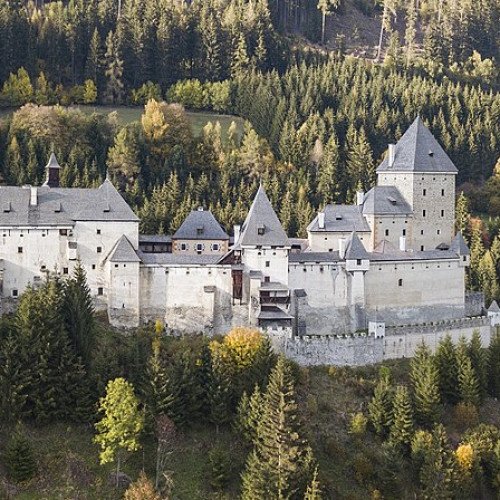Castles of "Austria" MAUTERNDORF CASTLE vs MOOSHAM CASTLE

MAUTERNDORF CASTLE
Mauterndorf Castle (German: Burg Mauterndorf) is a castle in the municipality of Mauterndorf, in the Austrian state of Salzburg. It is situated at an altitude of 1,138 metres (3,734 ft). Mautendorf Castle was probably built on the site of an old Roman fort that dates to 326 AD or earlier. It protected the Roman mountain road from Teurnia via Radstädter Tauern Pass to Iuvavum (present-day Salzburg) and served as a residence for the Roman administrator in the Noricum province. The original fort was destroyed during the Migration Period. A castle built on the site in later years was funded and supported by a toll (maut) collection system for the nearby road. Evidence for this comes from a deed gift issued by Emperor Henry II in the year 1002. "Dorf" is a German suffix for village or settlement. The castle itself was not mentioned until in 1253, th the time when the keep (Bergfried) was erected. Held by the Prince-Archbishops of Salzburg, the fortress was significantly enlarged under the rule of the archbishops Burkhard Weisbriach and Leonhard von Keutschach during the 15th century, to reach the form it still has today. The toll system on the Radtsädter Tauern Pass road supported the castle and village until 1803 when the toll collection was abandoned during the Napoleonic Wars. In 1806 the castle became a possession of the Austrian state. In 1894 Burg Mauterndorf was purchased by Hermann Epenstein (1851–1934), a Christian of Jewish descent, who served as a Prussian Army surgeon in Berlin. He refurbished and restored the decayed castle with great effort for use as a residence. In 1908 he obtained the minor title of a Ritter von Mauternburg by the Austrian emperor Franz Joseph I for his meritorious services and donation to the Crown.
Statistics for this Xoptio

MOOSHAM CASTLE
Moosham Castle (German: Schloss Moosham) is a medieval castle near Unternberg in the Lungau region of Salzburg, Austria. The spur castle is situated at a height of 1,079 metres (3,540 ft). Possibly built on the foundations of a Roman castrum fortress, the castle was first documented in an 1191 deed. It was seized by the Prince-Archbishops of Salzburg about 1285 and from the 14th century onwards served as the residence of an episcopal burgrave. Under the rule of Prince-Archbishop Leonhard von Keutschach from 1495, the castle was rebuilt and extended. In 1520, it became an administrative seat of the Lungau region and was besieged during the German Peasants' War of 1524–25. Archbishop Wolf Dietrich Raitenau stayed here on his flight from Salzburg in October 1611, shortly before he was captured. Moosham Castle served as the administrative center during the Zaubererjackl witch trials between 1675–1690. These trials led to the execution of 139 people. Unusually, most of those executed were male. Among those executed, 39 were children (between 10 and 14 years old), 53 were teenagers and young adults (between 15 and 21), 21 of unknown age; 113 were of male gender; everyone except two were beggars. The youngest was Hannerl, 10 years old, and the oldest was Margarethe Reinberg, 80 years old. 109 were executed during 1681. They were tortured and burned; some of them alive, others after having been hanged or decapitated – some of them after having had their hands cut off and marked with a burning iron. Archbishop Count Hieronymus von Colloredo dissolved the Moosham bailiwick in 1790, whereafter the castle decayed. In 1886, the Austrian explorer and patron of the arts Count Johann Nepomuk Wilczek purchased the ruin and had it restored. Up to today, the complex is private property, though its rooms featuring Wilczek's extensive art collection are accessible to the public.